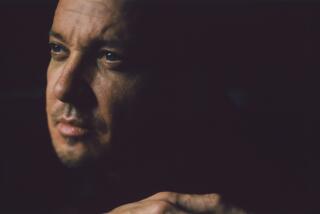The light shines anew
You have to be brave to visit the strange, hypnotic works known as “lumia” in the Museum of Contemporary Art’s show “Visual Music: Synaesthesia in Art and Music Since 1900.”
There’s minimal signage announcing the gallery devoted to these machines that silently form shifting abstract shapes and blended colors. And the long entryway is eerily dark. All that’s missing is an “abandon hope, all ye who enter” notice.
Yet on a recent Thursday evening, the isolated gallery constantly had visitors. Inside, the three lumia -- works by the late sculptured-light artist Thomas Wilfred -- provided the only light.
The works’ luminosity has a floating three-dimensional effect, like watching cloud formations from the inside. One is quite large -- 6 by 9 feet -- while the others are smaller but commanding. The oldest one here was made in 1932; the newest is 40 years old. Yet it’s easy to see why Wilfred said he was reaching for “cosmic consciousness.”
Wilfred is being reintroduced to museum-goers and curators via shows like “Visual Music,” which has other examples of color organs that produce projected-light abstractions. The multi-artist exhibition is up through May 23 at MOCA, then moves to Washington’s Hirshhorn Museum & Sculpture Garden, which co-organized it.
“It does seem to be something in the air right now,” Kerry Brougher, chief curator and director of art and programs at the Hirshhorn, says of Wilfred’s work.
“A younger generation has been inspired by digital technology to create a new kind of abstraction in motion. Curators and museum people have started to look back and see the roots of this movement -- to look at an alternative history of abstraction that’s driven by technology.”
The Danish-born Wilfred, who moved to the U.S. after World War I and died in Nyack, N.Y., at age 79 in 1968, compared his work to music -- as did pioneering 20th century abstract painters such as Wassily Kandinsky, also represented in “Visual Music.” Wilfred for a time gave performances at auditoriums and concert halls around the world. He used an instrument he built called a Clavilux, which looked like a huge mixing board.
Wilfred went on to make mechanisms that played unique self-contained light compositions via hidden parts such as color wheels, reflectors, lightbulbs and electric motors.
A West Los Angeles collector, now-retired radio-astronomer Eugene Epstein, took an interest in Wilfred after seeing his work in 1960. Epstein has since acquired nine lumia and two surviving Claviluxes. Only about 35 artworks by Wilfred exist.
“It was just an emotional, visceral experience,” Epstein says of Wilfred’s appeal. “As opportunities came up, I acquired them. And at a certain point, the rescuer instinct took over.”
One key indication of renewed museum interest came last year, when Epstein lent two pieces from his collection to the “Sons et Lumieres” exhibit at Paris’ Pompidou Centre. To his surprise, the Pompidou selected a swirling pink-and-blue photo of one -- 1965-66’s “Untitled, Opus 161” -- for the cover of its catalog, as well as for street banners and subway posters throughout Paris. (Both pieces are now in “Visual Music.”)
About the same time, the Tate Museum in Liverpool contacted him about lending Wilfred’s largest and last completed work, 1967-68’s “Luccata: Opus 162,” for its “Summer of Love: Art of the Psychedelic Era” show in May.
In addition, “Visual Music” has prompted the Hirshhorn to locate and restore a Wilfred piece that had been in storage. Judith Zilczer, the Hirshhorn curator emeritus who helped organize the show, was surprised to learn that the Smithsonian Institution -- of which the Hirshhorn is a part -- already owned a lumia.
A mural-sized projection, it had graced Clairol’s New York headquarters for decades after being commissioned in 1959. But in 1996, long after interest waned, Clairol’s then parent company, Bristol-Myers Squibb, gave it to the Smithsonian’s Museum of American History in Washington, which promptly shipped it to a warehouse in Virginia. It’s now featured in “Visual Music” and eventually will be displayed as part of the Hirshhorn’s permanent collection.
Meanwhile, Epstein and his nephew have set up a nonprofit foundation to restore a Clavilux and then train someone to give concert hall performances on it.
Several other American museums, from New Haven, Conn., to Honolulu, have Wilfred’s lumia in storage, Epstein says.
But the Holy Grail is “Opus 158,” which New York’s Museum of Modern Art commissioned from Wilfred in 1964 and had on display in its own room until about 1980. It became an underground hit.
In fact, MOCA assistant director Ari Wiseman says that during the “Visual Music” show “a lot of people flash back to their experience at MOMA.”
*
‘Visual Music’
Synaesthesia in Art and Music Since 1900
Where: Museum of Contemporary Art, 250 S. Grand Ave., L.A.
When: 11 a.m. to 5 p.m. Mondays and Fridays, 11 a.m. to 6 p.m. Saturdays and Sundays, 11 a.m. to 8 p.m. Thursdays. Closed Tuesdays and Wednesdays.
Ends: May 23
Price: $8 to $5; 11 and younger, free; Thursdays, free
Info: (213) 626-6222; www.moca.org
More to Read
The biggest entertainment stories
Get our big stories about Hollywood, film, television, music, arts, culture and more right in your inbox as soon as they publish.
You may occasionally receive promotional content from the Los Angeles Times.






